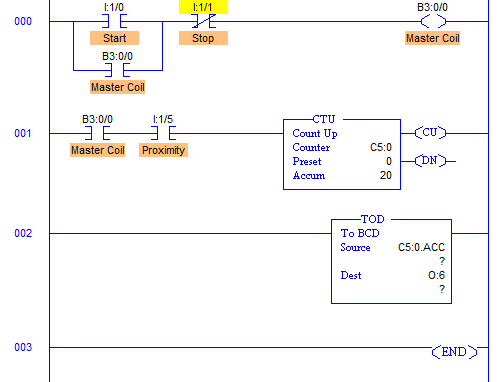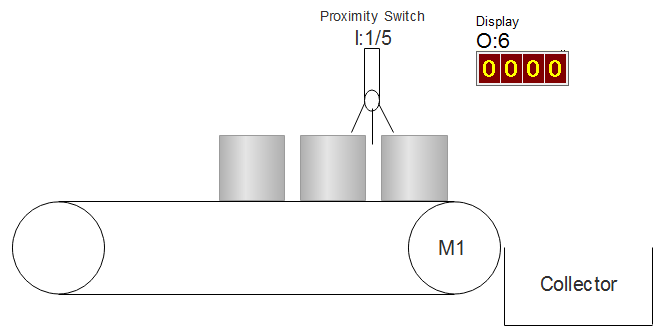This is a PLC Program for Counting of Parts from Conveyor.
Problem Description
Parts are moved on the conveyor. Count the number of parts collected at the end of the conveyor and display it on the display in PLC using Ladder Diagram programming language.
Problem Diagram
Problem Solution
- Mount Proximity Switch to detect the parts.
- Use output of proximity to counter as an input to increment data.
- Convert this number into appropriate numerical and show number of parts collected.
- Most widely Inductive and Capacitive Proximity switches are used to detect parts.
- Inductive Proximity are used to detect metal objects while to detect other objects, Capacitive Proximity Switch is most widely used.
- Capacitive Proximity detection capability ranges from 1 to 25mm distance.
- Mount this sensor according to the size of parts present on the conveyor and width of conveyor so that this sensor can detect parts easily.
- CUP is used to increment the number of parts collected.
PLC Program
Here is PLC program for Counting of Parts from Conveyor, along with program explanation and run time test cases.
List of Inputs and Outputs I:1/0 = Start (Input) I:1/1 = Stop (Input) I:1/5 = Proximity (Part detection) (Input) C5:0 = Counter Up (Counter) O:6 = Display address (Output) TOD = Hexadecimal to BCD conversion instruction (Compute) B3:0/0 = Latching Bit (Bit)
Ladder Diagram to count and display number of parts
advertisement
advertisement
Program Description
- RUNG000 is the master start/stop rung used to start and stop the counting process.
- RUNG001 is to count the number parts collected. Counter Up with address C5:0 is to count the number of parts collected. Whenever a part is detected by Proximity Switch, I:1/5 goes true momentarily and it increments accumulator value of the counter.
- RUNG002 is used to convert Decimal numbers into Binary Coded Decimal. Source address is given as C5:0.ACC and destination address is given as O:6 which is of Display. Converted BCD number is decoded by the display and the value present in accumulator of CUP C5:0 is displayed.
Runtime Test Cases
Inputs Outputs Elements I:1/5 = 1 (Momentarily) Counter Incremented Counter C5:0.ACC = 0 O:6 = 0 Display = 0 C5:0.ACC = 10 O:6 = 16 Display = 10 C5:0.ACC = 25 O:6 = 37 Display = 25
Sanfoundry Global Education & Learning Series – PLC Algorithms.
To practice all PLC programs, here is complete set of 100+ PLC Problems and Solutions.

